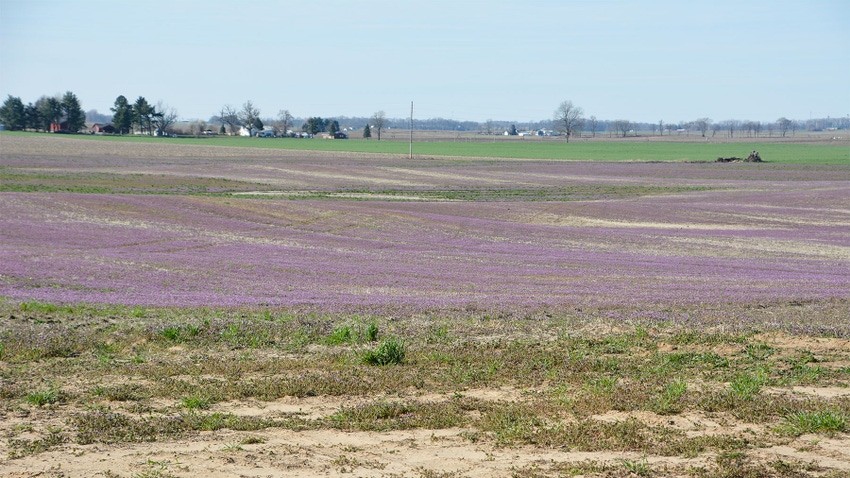
The list of top 10 stories viewed daily on the Indiana Prairie Farmer website showed an unusual entry recently. People were reading a story from late 2016 about crop fields turning purple. Why were people suddenly interested in an 8-year-old story?
When I visited Tom Nugent near Elnora, Ind., a few days later, I knew why. Approaching his farm, nearly every soybean stubble field was tinted with purple. Looking in every direction, unless a field was green with wheat, rye or other cover crops, it was purple. No wonder that by March 25, over 3,000 people had viewed the 2016 story about purple fields.
“The purpling is likely due to a mixture of henbit and purple deadnettle,” says Bill Johnson, Purdue Extension weed control specialist. “We’re likely seeing more of these winter annual weeds this spring than in recent years because it was such a mild winter overall. More weed seedlings than normal survived the winter, and now they’re taking off.”
The spring of 2016 apparently followed another fairly mild, dry winter. There was an outbreak of winter annuals that spring as well, which led to the story. When people Google “purple fields” now, the 2016 story is one that pops up.
What to spray on purple fields
If you no-till, you can spray these winter annuals and knock them out fairly easily. “These winter annuals are easy to kill with herbicides,” Johnson says. Roundup and 2,4-D will take them out, or Roundup and dicamba if you’re in the Xtend program. You can spray dicamba ahead of corn, and legally ahead of soybeans if you use one of the dicamba products labeled for over-the-top soybean applications.
Although a court ruling led to U.S. EPA pulling the label for over-the-top dicamba herbicides for dicamba-tolerant soybeans, the agency later issued an order allowing growers to use existing stocks of these products already in the system.
If you don’t no-till and rely on tillage instead of spraying, purple fields may be more problematic. Growers who have addressed the problem through spring tillage in the past report that dealing with clumps of dead plants left behind can make it more difficult to prepare a smooth seedbed and plant the field.
“An option for the future is fall applying herbicides and taking care of winter annuals then,” Johnson says. He notes that 2,4-D is a good option in the fall. Other products such as Princep, Valor, Canopy and Basis also can kill emerged and emerging winter annuals in a fall application.
About the Author(s)
You May Also Like




